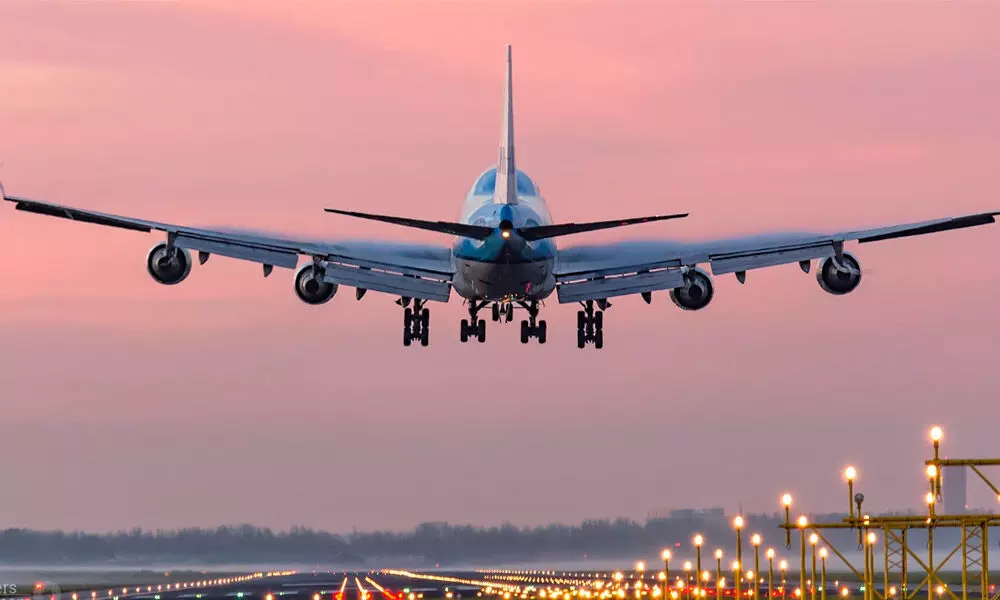Covid pushes aviation into deeper crisis
46 mn jobs supported by air transport sector are in peril now
image for illustrative purpose

Air transport drives the global economy. Some 88 million jobs and $3.5 trillion in GDP is supported by aviation. At least 46 million jobs supported by air transport are in peril.
Industry losses will continue into 2021, even though performance is expected to improve over the period of the forecast. A net loss of $118.5 billion is expected for 2020 and a net loss of $38.7 billion is expected in 2021. Aggressive cost-cutting is expected to combine with increased demand during to see the industry turn cash-positive in the fourth quarter of 2021.
Airlines have cut costs by 45.8 per cent, but revenues are down 60.9 per cent. The result is that airlines will lose $118.5 billion. This loss will be reduced sharply by $80 billion in 2021. But the prospect of losing $38.7 billion is still grim.
The Covid-19 crisis challenged the industry's survival in 2020. The dollar revenue drop was from $838 billion in 2019 to $328 billion but airlines cut costs by $365 billion. The year 2020 is the industry's worst financial year, bar none. Airlines cut expenses by an average of a billion dollars a day over 2020. The $173 billion in financial support by governments has cut bankruptcies on a massive scale.
Passenger numbers are expected to plummet to 1.8 billion from 4.5 billion passengers in 2019. Passenger revenues are expected to fall to $191 billion from $612 billion earned in 2019. Operational parameters for cargo are performing significantly better than for passenger but are still depressed compared to 2019: Uplift is expected to be 54.2 million tonnes in 2019, down from 61.3 million tonnes in 2019.
Cargo revenues are bucking the trend, increasing to $117.7 billion in 2020 from $102.4 billion in 2019. A 45 per cent fall in overall capacity, driven largely by the precipitous fall in passenger demand which took out critical belly capacity for cargo (-24%), pushed yields up by 30 per cent in 2020. Cargo is performing better than the passenger business and cargo revenues are making it possible for airlines to sustain their skeleton international networks. Airline financial performance is expected to see a significant turn for the better in 2021 but will be second only to 2020 performance.
Overall revenues are expected to grow to $459 billion. In comparison, costs are only expected to rise by $61 billion, delivering overall improved financial performance.
By the end of 2021 stronger revenues will improve the situation, but the first half of next year still looks extremely challenging. Passenger numbers are expected to grow to 2.8 billion in 2021. That would be a billion more travelers than in 2020, but still 1.7 billion travelers short of 2019 performance. Passenger yields are expected to be flat and the load factor is expected to improve to 72.7 per cent from the 65.5 per cent expected for 2020.
The cargo side of the business is expected to continue with strong performance. The important role that air cargo should play in vaccine distribution is expected to see cargo volumes grow to 61.2 million tonnes up from 54.2 million tonnes in 2020. A continued capacity crunch due to the slow reintroduction of belly capacity from passenger services combined with a higher proportion of time and temperature sensitive cargo (vaccines) will see a further 5 per cent increase in yields. This will contribute to strong performance in cargo revenues which are expected to grow to a high of $139.8 billion.
The road ahead is to safely re-open travel with systematic testing. The aviation industry cannot wait for a vaccine but can prepare for efficient vaccine distribution. Governments billions to keep Air Transport afloat, now they need to protect those investments and help airlines to safely do business.
While all regions are impacted by the crisis, airlines with larger domestic markets or with large cargo operations are performing better. Asia Pacific and North American carriers seeing the most significant reductions in expected losses.
India should be an ideal market for regional aviation because the majority of the population lives outside major cities, distributed across a large country. Many unique tourist attractions are located in remote areas. India needs turboprop, regional jet and commuter airline services to complement the national network. India requires an investment of $4-5 billion for little return but indirect economic and social benefits.

